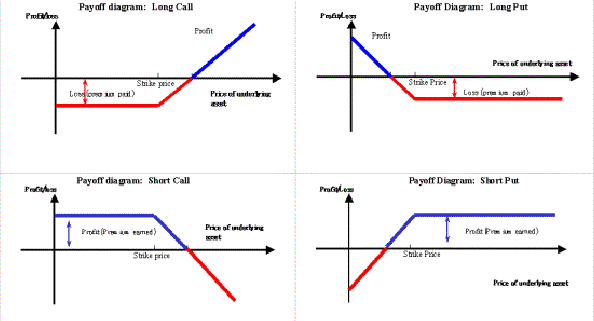Futures versus options
Although both are derivatives, futures and options are entirely different in terms of their potential risk and return.
How different are futures and options?
Rights vs. obligations - When trading futures, both the buyer and the seller must settle the futures contract regardless of how the underlying asset price moves. With options the buyer has the right, but not the obligation, to buy (call option) or sell (put option) the underlying asset. The option seller is passive and must comply with whatever the buyer decides to do.
Potential risk and return - Whether you buy or sell a futures contract, your potential gain or loss is unlimited. This is shown in the "symmetric" payoff diagrams. Both the potential gain and loss can far exceed the initial margin paid.
 |
However, the payoff for option trading is "asymmetrical". The potential gain when buying an option is unlimited, but the option buyer's risk is only limited to the premium paid. Since the buyer has to pay a premium, his potential gain is smaller than that for a futures contract, and the difference is the amount of premium paid. An option seller's profit is limited to the premium received. Given the option seller must meet the buyer's decision on exercise, the option seller's loss can be far greater than the premium received.
 |
Margin requirements - When trading futures, you have to pay a margin deposit to open a position regardless of whether you buy or sell a contract. For options, the buyer pays the premium (Note) when the contract starts, and does not have to post a margin. Only the option seller has to pay a margin. These short positions are also marked to market and the investors must abide by the margin requirements. However, a few exchanges have adopted a "futures-style" margining system where the option buyer does not pay a premium at the start of the contract. In this case, as with futures contracts, both the option buyer and seller have to post a margin and settle any losses arising from the daily mark-to-market process.
How do warrants differ from options and futures?
Warrants are a special form of option in which an investor can only take a long position - just like an option buyer. This means you can buy but not sell a call or a put warrant unless you sell the warrant to close out a long position previously established. Your maximum loss will therefore be limited to the amount you pay for the warrant.
The following table highlights the main differences between trading futures, options and warrants:
| Futures | Options | Warrants | |
|---|---|---|---|
| Right/obligation | Obligations | Rights for buyers; obligations for sellers | Rights |
| Risks (potential loss) |
Unlimited | Limited to premium paid for buyers; unlimited for sellers | Limited to premium paid |
| Opportunity (potential gain) |
Unlimited | Unlimited for buyers; limited to premium received for sellers | Unlimited |
| Margin requirement | Required | Option sellers only 1 | Not required |
| Premium cost | N/A | Required for buyers, but not for sellers | Required |
| Exercise style | N/A | American or European | American or European |
| Mark to market | Daily | Daily | N/A |
Note: This is the common practice. However, a few exchanges also require option buyers to post a margin rather than paying a premium, and their positions are marked to market.



